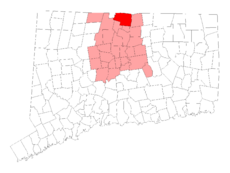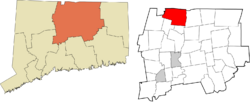Suffield, Connecticut facts for kids
Quick facts for kids
Suffield, Connecticut
|
||
|---|---|---|

The Suffield Public Library
|
||
|
||
| Motto(s):
"Our Roots Run Deep"
|
||
 Hartford County and Connecticut Hartford County and Connecticut |
||
| Country | ||
| U.S. state | ||
| County | Hartford | |
| Region | Capitol Region | |
| Settled | 1670 | |
| Incorporated (Massachusetts) | June 8, 1674 | |
| Annexed by Connecticut | 1749 | |
| Government | ||
| • Type | Selectman-town meeting | |
| Area | ||
| • Total | 42.9 sq mi (111.2 km2) | |
| • Land | 42.3 sq mi (109.5 km2) | |
| • Water | 0.7 sq mi (1.8 km2) | |
| Elevation | 197 ft (60 m) | |
| Population
(2020)
|
||
| • Total | 15,752 | |
| • Density | 366.88/sq mi (141.65/km2) | |
| Time zone | UTC−5 (Eastern) | |
| • Summer (DST) | UTC−4 (Eastern) | |
| ZIP Codes |
06078, 06093
|
|
| Area code(s) | 860/959 | |
| FIPS code | 09-74540 | |
| GNIS feature ID | 0212351 | |
Suffield is a town in Hartford County, Connecticut, United States. It is part of the Capitol Planning Region and sits in the Connecticut River Valley. In 2020, about 15,752 people lived there. The main part of town is called Suffield Depot.
Suffield is right next to Massachusetts. It is also part of the Springfield, Massachusetts area. Long ago, Suffield was actually part of Massachusetts.
Contents
History of Suffield
Suffield was first called Southfield. On May 20, 1674, a group planning the town asked for the name to be "Suffield." They said it was the most southern town in that area.
The Massachusetts Bay court agreed to this name on June 8, 1674. Suffield officially became a town in March 1682. Sometimes, on old maps from the 1600s and 1700s, it was spelled "Suthfield."
Important People from Suffield's Past
Many important people have connections to Suffield. These include:
- The Reverend Ebenezer Gay, a famous minister.
- Gideon Granger, who was a U.S. Postmaster General.
- Oliver Phelps, a real estate investor who once owned a lot of land.
- Composer Timothy Swan.
- Architect Henry A. Sykes.
- Sculptor Olin Levi Warner.
- Seth Pease, who surveyed lands in Ohio.
- Thaddeus Leavitt, who invented an early cotton gin.
Because Suffield was important and wealthy early on, it has many beautiful old New England buildings. The Kent family, for whom the town's library is named, had ties to many well-known families in early New England.
Some descendants of Robert Olds, who came from England in 1667, include:
- Ransom Eli Olds, a pioneer in the car industry.
- Robert Olds, a general in the U.S. Army Air Forces.
- Robin Olds, a famous U.S. Air Force fighter pilot.
Slavery in Early Suffield
In the 1700s, slavery was common in the Connecticut River Valley. A 1774 count showed 37 enslaved people in Suffield. Wealthy merchants, tavern owners, and ministers in the area owned slaves.
When Major John Pynchon bought the land for Suffield, he used two enslaved men, Harry and Roco, to build a sawmill. Reverend Ebenezer Devotion, a minister in Suffield, bought an enslaved person in 1726. Reverend Ebenezer Gay, another minister, owned six enslaved people.
In 1812, Reverend Ebenezer Gay Jr. freed his family's three remaining enslaved people: Titus, Ginny, and Dinah. "Princess," an enslaved woman belonging to an early settler, died in 1732. Some of this settler's family later became strong supporters of ending slavery. They even helped people escape to freedom through the Underground Railroad.
Early Doctors in Suffield
One of the first doctors in Suffield was Dr. Asaph Leavitt Bissell. He was born in 1791 and studied at Dartmouth College. He was also one of the first people to graduate from the Yale Medical School.
Dr. Bissell moved to Suffield and rode his horse to visit patients. His old saddlebags are now kept at the Yale Medical School's Historical Society.
Geography of Suffield
Suffield covers about 111.2 square kilometers (43 square miles) in total. Most of this is land, about 109.5 square kilometers (42.3 square miles). A small part, about 1.8 square kilometers (0.7 square miles), is water. The center of town, Suffield Depot, is about 5.1 square kilometers (2 square miles) of land.
Suffield is on the west side of the Connecticut River. It is about 8 miles (13 km) south of Springfield, Massachusetts. It is also about 16 miles (26 km) north of Hartford, the capital of Connecticut. Two bridges cross the river from Suffield to Enfield.
The Metacomet Ridge is a chain of mountains made of a type of rock called trap rock. This ridge runs through the middle of Suffield from south to north. It is known as West Suffield Mountain. The Metacomet Trail, a hiking path about 51 miles (82 km) long, goes along this ridge.
Population and People
Suffield has grown steadily over the years. Here's how the population has changed:
| Historical population | |||
|---|---|---|---|
| Census | Pop. | %± | |
| 1850 | 2,962 | — | |
| 1860 | 3,260 | 10.1% | |
| 1870 | 3,277 | 0.5% | |
| 1880 | 3,225 | −1.6% | |
| 1890 | 3,169 | −1.7% | |
| 1900 | 3,521 | 11.1% | |
| 1910 | 3,841 | 9.1% | |
| 1920 | 4,070 | 6.0% | |
| 1930 | 4,346 | 6.8% | |
| 1940 | 4,475 | 3.0% | |
| 1950 | 4,895 | 9.4% | |
| 1960 | 6,779 | 38.5% | |
| 1970 | 8,634 | 27.4% | |
| 1980 | 9,294 | 7.6% | |
| 1990 | 11,427 | 23.0% | |
| 2000 | 13,552 | 18.6% | |
| 2010 | 15,735 | 16.1% | |
| 2020 | 15,752 | 0.1% | |
| U.S. Decennial Census | |||
In 2000, there were 13,552 people living in Suffield. There were 4,660 households, and 3,350 families. The average household had about 2.55 people. The average family had about 3.04 people.
The population was spread out by age:
- 22.1% were under 18 years old.
- 8.0% were 18 to 24 years old.
- 31.7% were 25 to 44 years old.
- 24.1% were 45 to 64 years old.
- 14.1% were 65 years or older.
The average age in town was 39 years.
Most people in Suffield in 2000 were White (88.67%). There were also African American (6.95%), Asian (0.94%), and Native American (0.24%) residents. About 4.25% of the population was Hispanic or Latino.
The median income for a household in Suffield was $66,698. For a family, it was $79,189. This means half of the households earned more than this amount, and half earned less.
Arts and Culture in Suffield
Main Street in Suffield is a special historic area. It has the town Green, three churches, Suffield Academy, and many old colonial and Victorian homes. It looks like a classic New England town.
The Kent Memorial Library is named after the Kent family. It is an important place for finding old records and documents about north-central Connecticut. Walking along Main Street, you can see many examples of beautiful old buildings from the 1700s and 1800s.
The Dr. Alexander King House and the Phelps-Hatheway House are museums. They are open to the public from May to October.
Historic Places to Visit
Several places in Suffield are listed on the National Register of Historic Places. This means they are important historical sites. They include:
- Alexander King House
- Babb's Beach
- Farmington Canal-New Haven and Northampton Canal
- Gothic Cottage
- Hastings Hill Historic District
- Hatheway House (also called "Phelps-Hatheway House and Garden") – This house shows two styles: the original part from 1761 is colonial, and a newer part from 1794 is one of the first examples of the Neoclassical style in the area.
- Hilltop Farm
- John Fuller House
- King's Field House
- Lewis-Zukowski House
- Suffield Historic District
Education in Suffield
Suffield has its own public school system, called Suffield Public Schools. It includes:
- Spaulding Elementary School
- McAlister Intermediate School
- Suffield Middle School
- Suffield High School
Suffield is also home to Suffield Academy. This is a private school where both boys and girls attend.
Notable People from Suffield
Many interesting people have come from or lived in Suffield:
- Willis Seaver Adams (1842–1921), a landscape painter.
- Ran Blake, a pianist.
- Sylvester Graham (1794–1851), a dietary reformer, born in Suffield.
- Amos P. Granger, a former U.S. Congressman.
- Francis Granger, a former U.S. Congressman and Postmaster General.
- Gideon Granger, a former U.S. Postmaster General.
- George M. Hendee, who founded Indian Motorcycle.
- Chris Kellogg, a radio host.
- Titus Kent, an enslaved man who fought in the American Revolutionary War.
- W. Bruce Lincoln, a scholar of Russian history.
- Thaddeus J. Martin, a Major General in the United States Air Force.
- Eliphalet Remington, who founded Remington Arms, born in Suffield.
- David Newton Sheldon, the 5th President of Colby College.
- Israel Smith (1759–1810), who served in the U.S. House and Senate, and was Governor of Vermont; born in Suffield.
- Noah Smith (1756–1812), a judge and brother of Israel Smith.
- Timothy Swan (1758–1842), a composer.
- Emily Sweeney, a member of the 2018 U.S. Olympic luge team.
- John Tod (1779–1830), a U.S. Congressman for Pennsylvania.
- Jordan Stanley (1995-present), a writer and poet.
See also
 In Spanish: Suffield (Connecticut) para niños
In Spanish: Suffield (Connecticut) para niños





